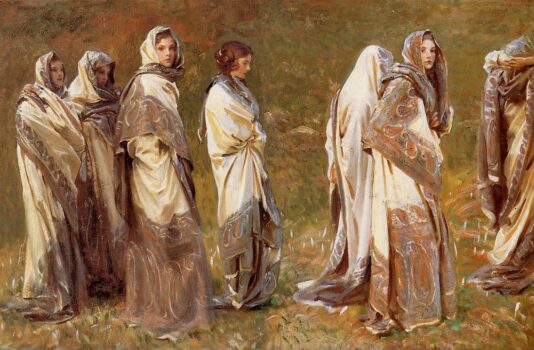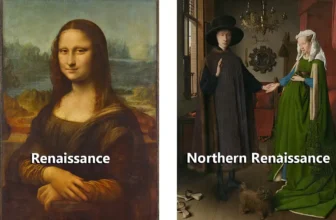Meaning of “Cashmere” Painting by John Singer Sargent
A Glimpse into a World of Silk and Shadow
In the rich panorama of Western art, few painters have blended technical brilliance with emotional nuance as effectively as John Singer Sargent. Known primarily for his luminous portraits of Edwardian aristocracy, Sargent also possessed a deeply curious and exploratory side. This more personal dimension of his work comes alive in his lesser-known yet intensely evocative painting, “Cashmere” (1908).
At first glance, “Cashmere” is a beautifully executed image of a young girl in various poses, each wrapped in exotic cashmere shawls. But beneath this aesthetic façade lies a complex interplay of identity, cultural fascination, and an artist’s personal moment of introspection. Let’s journey into the depths of this seemingly simple yet profoundly layered painting and explore what makes “Cashmere” a compelling piece in the canon of modern Western art.
Who Painted “Cashmere”? John Singer Sargent: A Brief Background
Before diving into the specifics of the painting, it is important to understand the creator behind it.
John Singer Sargent (1856–1925) was an American artist who is widely celebrated for his society portraits, capturing the likes of aristocrats, industrialists, and intellectuals with both grandeur and intimacy. Though born in Florence to American parents, Sargent was cosmopolitan by nature. He studied in Paris under Carolus-Duran and traveled extensively, drawing inspiration from various cultures and landscapes.
By 1907, however, Sargent was weary of the commissioned portrait work that had made him famous. He famously declared his retreat from “paughtraiture” and began focusing on watercolors, landscapes, and more informal compositions. It was during this phase of artistic exploration and liberation that “Cashmere” was painted.
The Story Behind the Painting: When, Where, and Who
“Cashmere” was painted in 1908 during a trip to the Italian Alps, where Sargent was traveling with family and friends. The primary subject of the painting is Reine Ormond, Sargent’s young niece and one of his favorite muses.
What makes this painting immediately striking is the multiplicity of the figure. Instead of portraying Reine in a single pose, Sargent renders her eight times, each version of her slightly varied in position and expression. The poses range from contemplative to curious, serene to animated. She is draped in colorful, flowing cashmere shawls, creating a visual rhythm and textural opulence across the canvas.
This technique of representing the same figure multiple times in a single frame was unusual for the period and places the work in dialogue with photography, performance art, and even modern filmic montage.
What is Happening in “Cashmere”?
On the surface, “Cashmere” is a study in form, light, and movement. Reine is seen in eight different poses, each enveloped in vibrant shawls, each captured at different angles. She appears seated, turning, looking sideways, or standing in profile. The focus is not just on the physical likeness but also on capturing the essence of movement, the transient moments of gesture, and the shifting play of fabric against skin.
There is no literal narrative in the painting, no story being acted out. Yet there is a profound emotional and psychological atmosphere. The viewer becomes a quiet observer of a private moment of playful experimentation, almost voyeuristic in its intimacy.
The setting is unadorned, with the background deliberately muted to draw attention to the cascade of colorful textiles and the youthful form they wrap around. This minimalist context places the focus squarely on the human figure and the rich cashmere, allowing the textures, patterns, and shadows to speak for themselves.
Symbolism and Deeper Meaning
At first glance, “Cashmere” might appear to be a simple decorative work, an aesthetic study of fabric and form. However, deeper layers of meaning can be unpacked through a symbolic and cultural lens.
1. Multiplicity of Identity
The repetition of Reine across the canvas speaks to the concept of multiplicity of self. Each iteration of the girl presents a slightly different persona, shy, bold, thoughtful, curious. This mirrors the way identities are formed not as singular or fixed but as multifaceted and fluid. Sargent, by refusing to settle on one pose or personality, may be alluding to the complexity of adolescence, the transition from childhood to womanhood, and the elusiveness of personal identity.
2. Orientalism and Exoticism
The painting is saturated with Orientalist aesthetics. Cashmere shawls, luxurious and foreign, were viewed in the West as exotic treasures, symbols of opulence and the “mystique” of the East. The fabric itself originates from Kashmir, a region renowned for its weaving traditions. In Sargent’s era, European and American artists were often fascinated by Asian and Middle Eastern motifs, sometimes appreciatively, often problematically.
While Sargent’s depiction avoids overt stereotyping, the use of Eastern textiles to clothe a Western subject still places the painting within a broader tradition of Western Orientalism, where “the East” becomes a stage upon which European dreams and fantasies play out. Yet Sargent seems aware of this dynamic and uses it not as a prop for cultural domination but as a poetic device.
3. Femininity and Transformation
The shawls act not just as garments but as transformative veils. They hide and reveal, conceal and display. Draping the young girl in fabrics typically associated with mature femininity could suggest a symbolic rite of passage, or a meditation on the thresholds between innocence and experience. The cashmere, soft yet luxurious, becomes a metaphor for both protection and seduction, an artistic gesture toward the liminal spaces of girlhood and womanhood.
Artistic Technique and Style
“Cashmere” exemplifies Sargent’s legendary command of technique. It is executed in oil on canvas, and his brushwork is fluid, confident, and expressive. The piece is less tightly controlled than his formal portraits, allowing for a looser and more spontaneous feel.
Key stylistic elements include:
Expressive brushstrokes: The brushwork suggests the delicate folds of fabric and the texture of skin with effortless grace.
Color harmony: Rich jewel tones of the shawls, deep reds, blues, and golds, stand out against the neutral background, creating a dynamic balance.
Light and shadow: Subtle modulation of light enhances the volume of the figures and the fabric, producing an almost three-dimensional effect.
Sargent blends elements of Impressionism, especially in the treatment of light and color, with classical figuration. The result is a hybrid style that defies easy categorization but remains unmistakably his own.
What Type of Art is “Cashmere”?
“Cashmere” can be classified as a figurative painting, yet it also borders on genre painting and symbolist art due to its introspective and suggestive qualities.
While not abstract or surreal, the painting doesn’t conform strictly to realism either. It exists in a liminal space between portraiture and conceptual art, combining the representational with the poetic. The work also hints at early forms of performance art, given that the subject seems to enact a visual choreography of poses, all staged and captured within one frame.
What Does “Cashmere” Represent?
At its core, “Cashmere” is an exploration of beauty, identity, transformation, and the passage of time. It’s a meditation on:
The evolving sense of self in youth
The dialogue between West and East through visual culture
The joys of artistic freedom and experiment
It also represents a moment of personal liberation for Sargent. Having broken free from the commercial constraints of society portraiture, he was free to follow his own interests. In doing so, he produced a painting that, while less famous than his grand society portraits, reveals the soul of an artist at peace with his craft and immersed in the quiet joy of observation.
Where is “Cashmere” Painting Today?
Today, the painting is held in the collection of the Museum of Fine Arts, Boston. It remains one of the lesser-publicized treasures of their Sargent collection, often admired by those who seek out the more personal and introspective side of the artist.
Visitors to the museum can view the painting in a setting that allows close observation of its intricate detail and subtle color harmonies. Its preservation in Boston, alongside many of Sargent’s other works, testifies to the deep relationship between the artist and the city, where many of his patrons and admirers resided.
“Cashmere” by John Singer Sargent is more than a technical marvel or a decorative indulgence. It is a quietly revolutionary painting that bends genre conventions and invites viewers to contemplate identity, culture, and the delicate ephemerality of human expression.
Through a deceptively simple motif, a girl wrapped in shawls, Sargent delivers a complex visual essay on beauty, cultural exchange, and the infinite variety contained within a single life. It is a painting that continues to whisper to its viewers, long after the initial glance, revealing new meanings each time we return to it.




